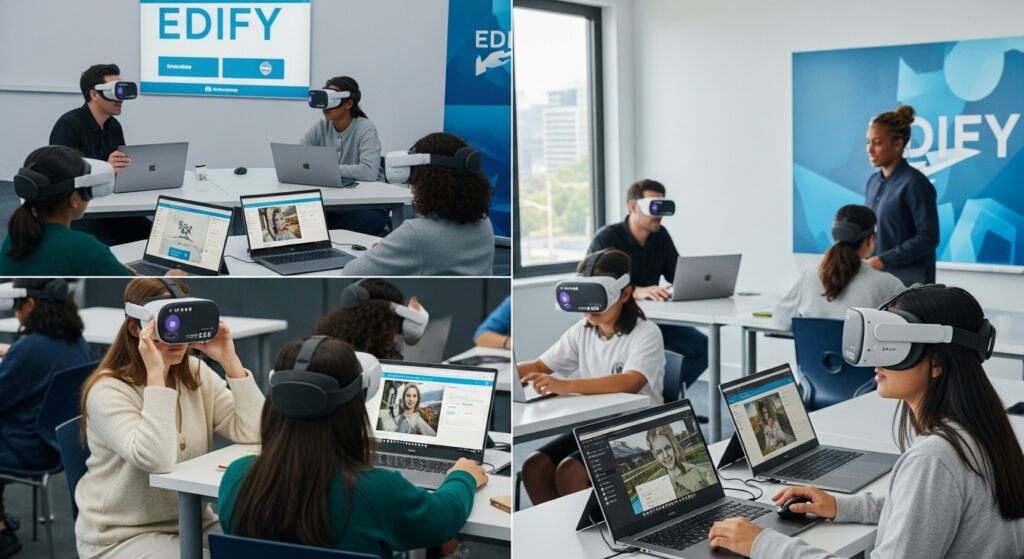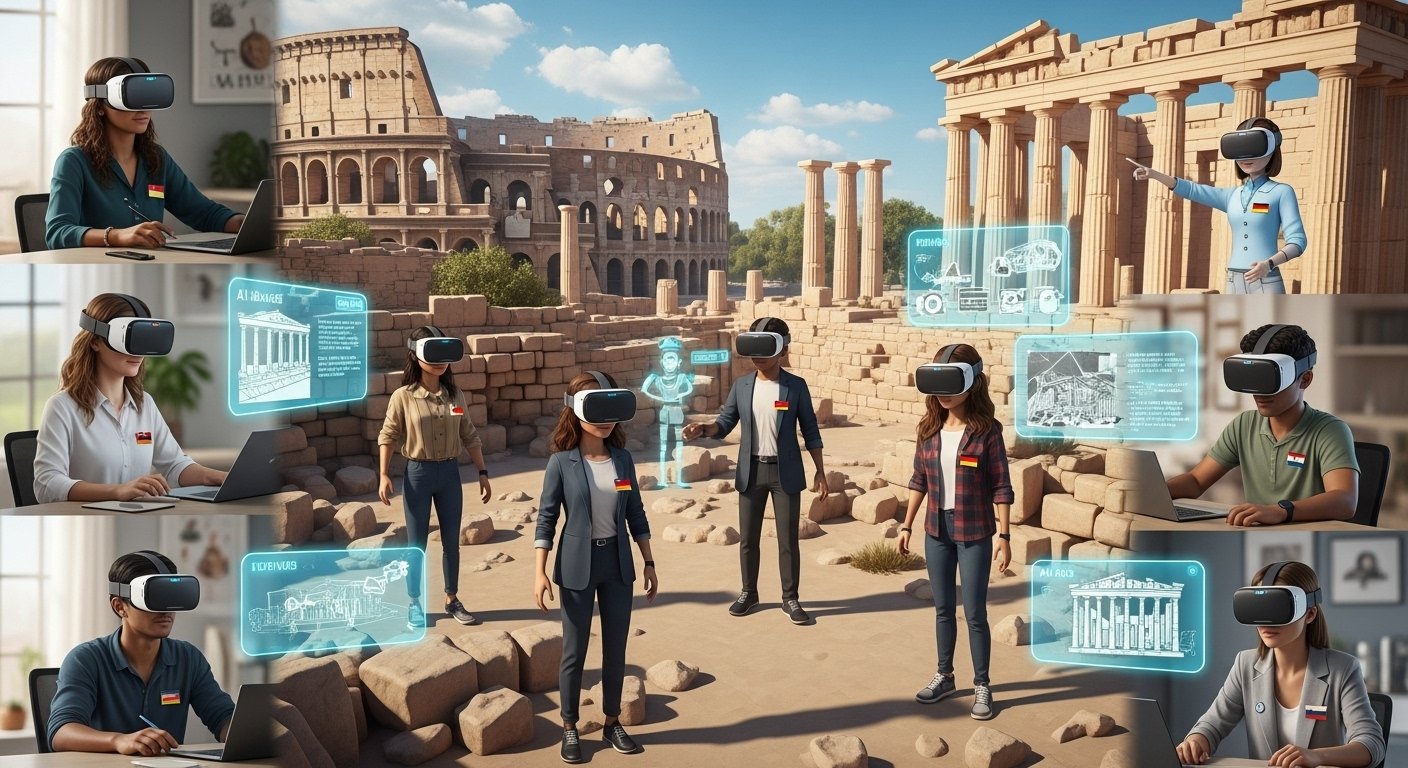In an era where digital transformation sweeps through every corner of education, immersive technologies like virtual reality (VR) and artificial intelligence (AI) are not just buzzwords—they’re becoming essential tools for effective learning. The rise of leading AI VR education platforms is changing how students learn, how teachers teach, and how institutions deliver curricula. From students visiting virtual historical sites to AI-driven tutors adapting lessons in real time, the potential is enormous. In this article, we’ll explore the why and how of these platforms—with real life examples, adoption stats, benefits and caveats—to help you understand the space and decide what might make sense for your context.
Why use AI + VR in education?
Before we dive into specific platforms, let’s set the stage by looking at why combining AI and VR in education matters.
The case for immersive and intelligent learning
Here are some key reasons these technologies are gaining traction:
-
Engagement and retention: Immersive VR experiences place learners inside the environments they study (for example, walking through molecular structures or exploring historical sites), which research suggests can significantly boost knowledge retention.
-
Personalisation through AI: AI tools can adapt content, pacing, difficulty and feedback to individual learners—something that’s hard to scale in traditional classrooms.
-
Access and flexibility: VR allows learners to access labs, field trips or simulations that would otherwise be prohibitively expensive or logistically impossible (e.g., remote labs, virtual world trips). AI can support off-hours, remote learners, asynchronous learning.
-
Real-world readiness: For technical, vocational or STEM education, VR simulations reduce risk and cost (e.g., chemistry labs, medical simulations) while AI provides analytics and feedback.
-
Global trends: According to recent data, adoption of AI and VR in education is growing steadily — for example, 71% of educators in a global study believe these tools improved student engagement; 64% reported better comprehension with AI/VR tools.
A snapshot of current adoption
-
In one survey, 82% of college students reported using AI technologies, while only 58% of high-school students did — indicating high adoption in higher education.
-
A market-study noted the AI + VR in education market grew by 31% in 2022.
-
VR simulations in STEM increased by some 50% in 2023 in certain segments.
These numbers highlight both momentum and opportunity—but also signal areas (like K-12 or low-resource regions) where adoption might lag.
What to look for in “leading AI VR education platforms”
If you’re exploring platforms, you’ll want to evaluate based on:
-
Cross-platform accessibility: Works on desktops, mobile, VR headsets (and importantly, has fallback for non-VR users).
-
AI capabilities: Adaptive learning, AI-driven feedback, intelligent avatars/tutors, analytics.
-
VR immersion & content quality: High fidelity simulations, interactive 3D models, multiplayer/collaborative VR, meaningful pedagogy not just novelty.
-
Ease of authoring: Platforms that allow educators to build or customize experiences without heavy coding.
-
Scalability & institution readiness: Headset management, licensing, IT integration, data/privacy compliance.
-
Pedagogical grounding & outcomes: Evidence of improved learning, retention, engagement; not just flashy tech.
-
Global/local fit: Especially for contexts like Pakistan, availability of local curriculum alignment, device cost, internet/bandwidth readiness matter.
Top platforms in the space
Here are some of the standout platforms in the “leading AI VR education platforms” category, with features, use-cases and what makes them unique.
1. VictoryXR

VictoryXR offers a full ecosystem of VR + AI for education (K-12, higher ed, commercial training). Their platform includes:
-
VXRLabs: immersive VR labs and experiences across science, history, literature, career/technical education.
-
3D Spatial AI / HOLOTUTOR: conversational AI tutors, no-code tools for custom AI teaching assistants.
-
Digital Twin “Metaversity” campuses: full virtual replicas of institutions for immersive learning, orientation, global student collaboration.
-
They report improvements in attendance, engagement and student satisfaction from institutions using their solutions.
Why it stands out: Very complete offering spanning VR + AI, covers K-12 through higher ed; has real case use-data.
Considerations: Requires VR headsets for full immersion (though PC/chromebook support exists) and institutional investment in hardware, training and infrastructure.
2. Edify

Edify is a platform aimed at immersive learning and training, with a strong emphasis on ease of creation and accessibility. Key features:
-
Supports desktop, mobile and VR headsets — includes “VR-by-proxy” mode so students without headsets can participate via Zoom/Teams.
-
No-code content creation: educators can build immersive lessons using libraries of 3D objects/environments and import their own models/data.
-
Analytics/insights: measure teaching implementation, student engagement and performance.
-
Use-cases span higher education, enterprise training and remote/blended learning.
Why it stands out: Strong on accessibility (both hardware and user-skill), good for institutions that need flexibility and non-VR fallback.
Considerations: While immersive, some of the deepest VR benefits may still require headsets; enterprise pricing may still be significant for smaller schools.
3. ENGAGE XR

-
Supports VR, AR, PC, Mac, mobile devices, enabling inclusive access.
-
Includes no-code content creation tools, AI asset generation (avatars, characters), virtual field trips, multi-user collaborative spaces.
-
Education-specific solutions: e.g., at Bett 2025 they showcased an EDU package with AI historical characters for K-12.Used in university/medical training settings (e.g., virtual labs) and corporate training too.
Why it stands out: Strong on multiplayer collaboration, large scale deployment, cross-device flexibility and AI support; good for institutions looking for immersive experiences and modern “metaverse” style learning.
Considerations: Deployment of VR headsets at scale still requires logistics/training; ensuring curriculum integration and teacher buy-in are critical for success.
4. Other noteworthy platforms
While the three above are prominent, there are other platforms and tools contributing to the space of leading AI VR education platforms—especially in specific niches (vocational training, K-12, language learning). For example:
-
ClassVR (with content library Eduverse) supports K-12 immersive VR/AR across many countries.
-
Platforms specialising in AR/VR content for STEM (e.g., those listed in AR/VR education trend articles).
-
Custom enterprise/education solutions that integrate adaptive AI with immersive VR experiences (e.g., research projects like DataliVR).
Benefits and real-life outcomes
Let’s summarise some of the concrete benefits and real-life evidence for these platforms.
Key benefits
-
Improved engagement: Immersive worlds attract attention and make abstract concepts tangible (e.g., walking through a molecule, visiting a virtual volcano).
-
Better retention: Studies show VR-based learning often leads to higher retention and better comprehension compared to traditional methods.
-
Accessible high-cost experiences: Simulated labs, virtual field-trips and global travel become possible in VR at lower marginal cost.
-
Personalised learning: AI-driven feedback adapts to learners’ pace, identifies gaps, offers targeted practice.
-
Scalable collaboration: Students from disparate geographies can meet in a virtual classroom, collaborate in groups, practice soft skills.
-
Motivation & novelty: The “wow” factor of VR combined with meaningful pedagogy can boost motivation, especially for younger learners.
Real-life outcomes & stats
-
The EssayPro 2025 study found that 71% of educators believe AI/VR tools have improved student engagement and 64% reported better comprehension.
-
The market data: AI in VR education market grew by 31% in 2022.
-
According to ENGAGE XR’s platform description: at University of South Carolina the introduction of VR in introductory biology labs saw D grades drop by 86% in one semester, and F grades by 45.96%.
These outcomes show strong promise—but they also underscore the importance of well-designed experiences, not just hardware or novelty.
Challenges and what to watch out for
No technology is a silver bullet. Here are important considerations when adopting leading AI VR education platforms.
Practical and pedagogical hurdles
-
Hardware & infrastructure cost: VR headsets, sufficient computers, secure networks and management systems add cost.
-
Teacher training and adoption: Many teachers need training on how to use VR/AI effectively; without that, technology can become a distraction. In one educator forum:
“I have a teacher that went out and bought an Oculus Quest 2 and wants to use it… How are you ensuring FERPA and [StateFERPA] compliance?”
-
Content quality & integration: Immersive experiences must align with curriculum and learning objectives. One study pointed out: “Immersive advantage of VR in enhancing user satisfaction … but more research is needed how it can be implemented into broader teaching strategies.”
-
Digital divide / equity: Students without access to VR hardware or robust internet may be disadvantaged. From adoption data: high usage in universities, lower in schools.
-
Over-reliance on novelty: If VR is used just as a gimmick without pedagogical scaffolding, engagement may fade. One Reddit comment:
“It’s a solution looking for a problem… I have never seen a VR/AR solution that has any solid student performance ROI.”
-
Data privacy and safety: AI systems often collect student data; VR environments involve immersive experiences—proper policy and governance are essential.
How to address these challenges
-
Start with pilot programs before full roll-out: choose one subject or grade, measure outcomes.
-
Ensure teacher professional development is in place: equip teachers not just with hardware but with pedagogy for immersive learning.
-
Use hybrid models: Not every student may have a headset—choose platforms that allow non-VR access (e.g., Edify’s “VR-by-proxy”).
-
Focus on content alignment: Immersive tools should map to curriculum goals, not be used solely for “fun”.
-
Budget realistically: include hardware, software licensing, training, maintenance, content updates.
-
Monitor metrics: participation, retention, comprehension, grades, student feedback.
-
Ensure access equity: plan for students with limited devices or connectivity.
-
Mind privacy/security: choose platforms with clear data governance, device management, user controls.
How institutions can evaluate & adopt leading AI VR education platforms
If you’re an administrator, educator or decision-maker considering these platforms, here’s a roadmap:
Step-by-step adoption guide
-
Define your goals
-
What are you trying to improve? Engagement? Retention? Practical skills?
-
Which subjects or student groups will benefit most (STEM, vocational, language, humanities)?
-
What is your budget and timeline?
-
-
Assess your infrastructure
-
Do you have headsets? How many? Do you have PCs/devices that support VR or fallback modes?
-
Internet/Bandwidth capacity, device-management systems, IT support.
-
Data/privacy policies, user-accounts, teacher training resources.
-
-
Short-list platforms
-
Use criteria like: accessibility, AI adaptation, content quality, educator authoring tools, device support, cost.
-
For example: VictoryXR (strong full-stack VR+AI), Edify (strong in accessibility and simplicity), ENGAGE XR (strong in collaboration/multiuser).
-
Evaluate demos/trials.
-
-
Pilot program
-
Choose one grade/class or subject.
-
Set metrics (student engagement, discipline, comprehension, feedback).
-
Train teachers. Run for one term or term + review.
-
Collect feedback: students, teachers, IT staff.
-
-
Evaluate & scale
-
Compare outcomes vs baseline.
-
Consider hardware scaling, training plan, cost per student.
-
Determine full rollout: phased by grade, subject or campus.
-
-
Continuous improvement
-
Update content regularly.
-
Provide teacher community of practice.
-
Monitor analytics (many platforms offer dashboards).
-
Address equity: ensure all students benefit.
-
Tips specific to Pakistan / resource-constrained settings
-
Choose platforms that support non-VR device access (desktop/tablet) when headsets are limited.
-
Consider mobile-based VR or lower-cost headsets.
-
Focus initial pilot on subjects with higher impact (STEM labs, vocational training) where virtual labs save significant cost.
-
Leverage local partnerships and grants; check if platforms offer education discounts.
-
Train teachers with blended workshops (in-person + online) and pair “tech champions” with early adopters.
-
Monitor device usage, connectivity issues, power/maintenance overheads.
Future trends in AI + VR education
Looking ahead, the “leading AI VR education platforms” space is evolving rapidly. Some emerging trends:
-
Generative AI + Avatars in VR: immersive virtual tutors/assistants powered by large-language models (LLMs) inside VR worlds. For example: research like DataliVR integrates ChatGPT-like avatars in VR for data-literacy education.
-
Neuroadaptive VR: Systems that monitor student cognitive states (eye-tracking, facial cues) and adapt VR content in real time.
-
Metaverse learning spaces: Virtual campuses, global classrooms, peer collaboration across geographies (e.g., VictoryXR’s digital twin campuses).
-
Hybrid physical/virtual labs: Using VR for remote lab practice, then physical labs for hands-on; blending AI analytics for performance feedback.
-
Increased scalability and affordability: As device costs drop (and mobile VR improves), more schools globally (including developing countries) will adopt immersive platforms.
-
Curriculum-embedded immersive modules: VR/AI modules will become standard parts of curriculum (not just add-ons).
-
Data ethics and governance frameworks: As immersive/AI systems collect more data, frameworks for privacy, equity and accessibility will become more stringent.
Conclusion
In summary: the world of leading AI VR education platforms offers a compelling vision of how learning can be more immersive, personalised and effective. Platforms like VictoryXR, Edify and ENGAGE XR demonstrate how combining artificial intelligence with virtual reality can elevate educational experiences—making labs safer, global field-trips possible, tutoring adaptive, and collaboration seamless across locations.
However, adoption isn’t simply a matter of buying headsets or software. Success hinges on thoughtful planning: aligning with pedagogy, training teachers, ensuring infrastructure and equity, piloting carefully, and scaling with purpose. When done well, the result is not just “cool tech”, but real improvements: higher engagement, better retention, wider access.
For institutions in Pakistan or elsewhere, embracing these platforms requires balancing ambition with pragmatism—choosing solutions suited to your context, starting small, building capacity and monitoring impact closely.
If you’re exploring this further, it’s worth scheduling demos, requesting pilot licenses, and getting feedback from teachers and students early on. The future of education is immersive—and the leading AI VR education platforms are at the heart of that transformation.
FAQs
Q1: What exactly counts as an AI + VR education platform?
An “AI + VR education platform” is a learning system that combines virtual reality (VR/immersive worlds) for visualization, interaction and immersion with artificial intelligence (AI) for adaptiveness, feedback, analytics or virtual tutor support. For example, a VR chemistry lab where AI monitors student performance and suggests remedial steps.
Q2: Are these platforms only for higher education or expensive schools?
Not necessarily. While many early adopters are in higher ed (due to resources), there are platforms designed for K-12, schools and remote/blended learning. Some platforms support non-VR access (desktop/tablet) or offer lower-cost headsets. The key is choosing a platform suited to your scale and budget.
Q3: Do students need a VR headset to benefit from these platforms?
Not always. Some platforms support “VR-by-proxy” or desktop/mobil e access so students without headsets can join. However, full immersion often requires a headset. It’s a good idea to plan for mixed access and fallback options.
Q4: What roles do teachers play in this model?
Teachers remain central: they guide, facilitate, design or customise immersive lessons, monitor student progress via analytics, and integrate the VR/AI experiences with broader curriculum and assessments. Technology is an enabler, not a replacement.
Q5: How do I measure if such a platform is working?
Common metrics include: student engagement (attendance, participation), comprehension/retention (pre- and post-tests), performance (grades or skill assessments), teacher feedback (ease of use, pedagogy fit), cost per student, and device/technology issues (uptime, access).








Leave a Reply